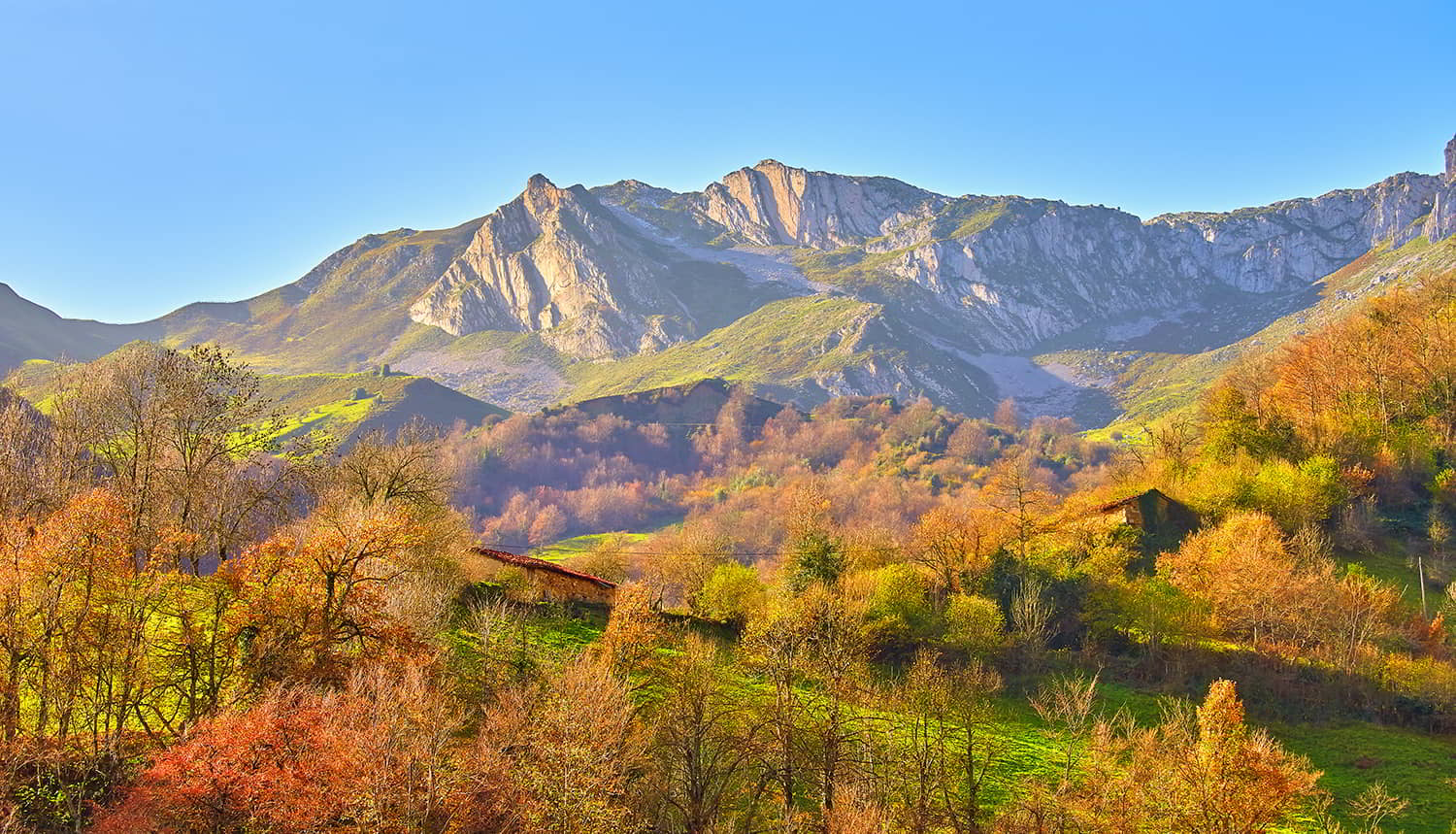Back Top 10 things to see and do in the region of Picos de Europa
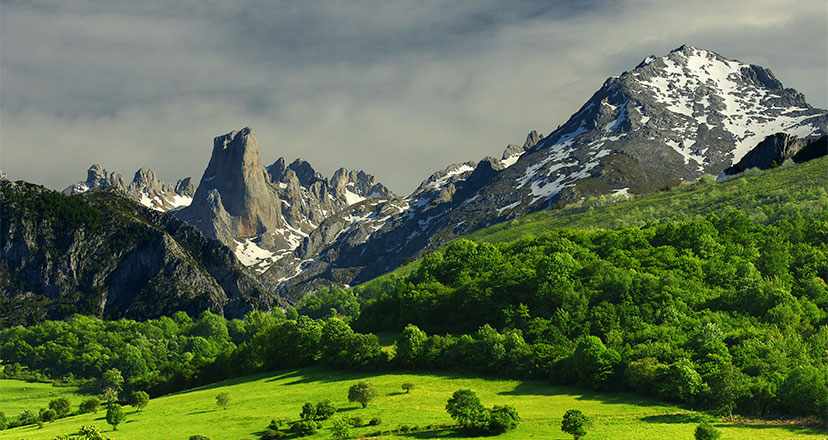
Top 10 most interesting things to see and do in the Picos de Europa Region
Do you know this region? There are many things to see in Picos de Europa, offering natural, cultural, gastronomic, ethnographic and human attractions.
The Picos de Europa region is one of those places where there is no time for boredom. There are many and varied things to see in Picos de Europa, and you can combine landscape, nature, culture, gastronomy and the most rewarding experiences. And, of course, you'll have a great time in a Biosphere Reserve such as the Picos de Europa National Park.
We suggest the 10 best things to see in Picos de Europa!
Dozens of villages, a town that was once the capital of a Kingdom, routes, viewpoints, sheepfolds and shepherds, cheese dairies, museums, dream landscapes... All this and much more in the Picos de Europa Region.
A visit to Cangas de Onís, the first capital of the Kingdom of Asturias
There are many beauties to see in Picos de Europa, and one of them is the town of Cangues d'Onís/Cangas de Onís. The motto on its coat of arms says of it "Mínima Urbium, Máxima Sedium", that is to say, "the smallest of cities, the largest of capitals", and this is because the small village of Canicas (as Cangas was called in the Middle Ages), was of great importance in the origin of the Kingdom of Asturias, of which it was the first capital. And the truth is that it still retains that historical imprint of the important events it played a leading role in.
Undoubtedly, one of the traces of that time can be seen in the Church of Santa Cruz, located in the heart of Cangues d'Onís/Cangas de Onís, which was built in the year 737 by King Favila, son of King Pelayo. It is believed to have been called Santa Cruz because it housed the oak cross that Pelayo carried in the battle of Cuadonga/Covadonga and which would later become the Cross of Victory. It is also believed to be the first Christian temple to be built in Asturias and Spain after the Islamic invasion. The temple also contains a dolmen, dated to 3000 BC.
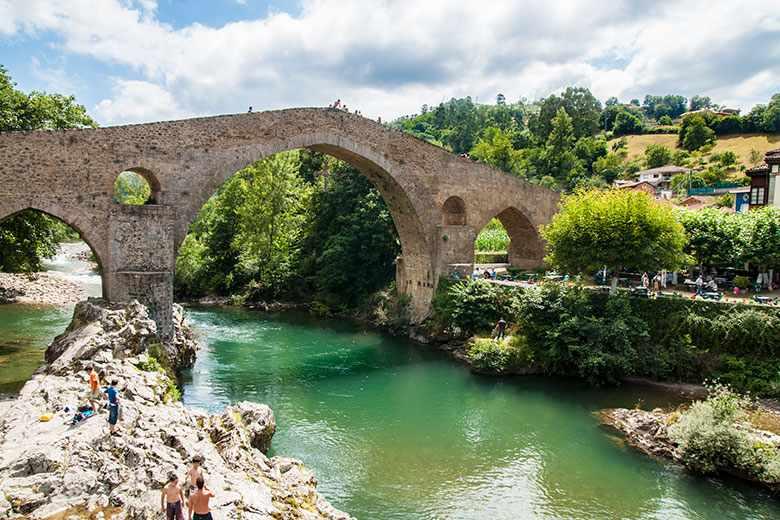
Another of these remnants of the past is the Roman Bridge, one of the most iconic and photographed places in Asturias, due to its charm and beauty. Also known as the "puentón", it is a medieval construction over the river Sella, linked to the Roman road that connected what is now Lugo de Llanera with Santander. Its fluvial environment is a salmon farming area.
But Cangues d'Onís/Cangas de Onís is much more than history: it has one of the oldest, most genuine and lively Sunday markets in the whole of Asturias (very interesting to visit the Market Square, and if it is on a Sunday, ideal). And while you're there, take the opportunity to stroll along San Pelayo street and the old part of the town, finishing the walk at the statue of Pelayo and the Church of the Assumption.
Another interesting option is to go to a cider house or restaurant, and get to know the local cuisine, as well as its gastronomic and craft shops.
Of course, you cannot leave without visiting the Casa Riera ( almost opposite the Roman Bridge), a magnificent example of Indian architecture and current tourist office, where there is also an exhibition of the culture of the area, and in its surroundings a wonderful park and promenade to enjoy the river Güeña, which joins the Sella in this town.
Covadonga and its Sanctuary
The first thing you come across when you arrive at Cuadonga/Covadonga is the Santa Cueva - known as "Cova Dominica" or "Cueva de la Señora" - a place of worship and pilgrimage where the Virgin of Covadonga is found, which radiates peace and tranquillity. Located in a natural grotto, in the foothills of Mount Auseva, its setting of mountains and vegetation is spectacular, and it is thought that it may have been a cave hermitage in the time of King Pelayo.

In the Cave lie the remains of D. Pelayo, the first king of the Asturian monarchy, and of his son-in-law Alfonso I.
Right next to the Cave is the Renaissance Collegiate Church of San Fernando, built over the original monastic settlement dating from the 12th century, and excavated in the living rock of the Picos de Europa.
Another natural feature of this grotto is that underneath it there is a cavity which, during the rainy season or thawing of the snow, is filled with an impressive waterfall known as the ' chorrón del río Mestas', which flows into the famous 'pozón' - a pool of crystalline waters - where the traditional ritual consists of throwing a coin to make a wish.
On the banks of the 'pozón' is the mythical Fountain of the Seven Spouts, to which popular literature attributes magical powers, claiming that "the Virgin of Covadonga has a very clear fountain. The girl who drinks from it gets married within a year".
Among the many things to see in Picos de Europa, there is also the Basilica of Cuadonga/Covadonga, a "cathedral" in the middle of nature, which has been a historical and spiritual symbol for more than a century, and whose interior is notable for the altar, the choir stalls, the organ and the crypt. Built on the Cueto hill - an elevation opposite Mount Auseva - from its esplanade you will have privileged views of the Holy Cave, Mount Priena, the ascent to the Lakes, the Prince's forest and the surrounding natural environment.
Also, don't miss the Museum of Cuadonga/Covadonga, located in what used to be the old Hotel Favila, and climb the stairs that take you up to the famous Campanona, a unique piece that was awarded a prize at the Universal Exhibition in Paris in 1900, and from where you have a beautiful view of the Basilica.
The Lakes, a classic of nature tourism
The Covadonga Lakes, just 12 kilometres from the Sanctuary, are a wonder of the world. Travellers from all over the world are captivated by its landscape and the atmosphere that its ecosystem provides.
The famous lakes are two: La Ercina, with the summit of Peña Santa de Enol projecting into the sky, with its eternal snow-capped peaks. And meanwhile, the sound of the Asturian mountain cows, giving the most beautiful open-air concert you have ever heard. And Enol, with its meadow, its refuge, its chapel or its club, knowing that under its waters there is a replica of the Virgin of Covadonga, which divers bring to the surface every 8th of September.
There is also a temporary lake called El Bricial, which you can reach by the shepherds' paths that leave from the meadows of La Ercina or Enol. El Bricial is at the foot of the peak of the same name, and just opposite is the beech forest of Mount Palomberu, another wooded wonder of the Picos de Europa National Park. The best time to see this curious "intermittent" lake is in spring, coinciding with the thaw. You will see that you can do a circular route, i.e. go via La Ercina and return via Enol, or vice versa.
The Covadonga Lakes, admired by travellers, portrayed by artists, researched by scientists, the goal of sportsmen and women, are one of the most filmed places on the planet, especially as a result of being, on several occasions, the end of the stage of the Tour of Spain.
A refuge for shepherds, creators of one of the best cheeses in the world, Gamonéu, the lakes are a reference point for hikers, mountaineers and nature lovers.
Picu Urriellu, an international climbing icon
Among the most notable landmarks to see in Picos de Europa is the Picu Urriellu, also known as Naranjo de Bulnes, an emblematic summit of the Central Massif of the Picos de Europa. And it is emblematic and unique for several reasons: Because you can only reach its summit by climbing, because it was the last great European summit to be conquered by mountaineers, because of the complexity of its ascent in winter, and because it is the origin of Spanish mountaineering.
In 1904 Pedro Pidal and Gregorio Pérez "el cainejo" were the pioneers in the conquest of this summit, which would become throughout the 20th century and into the present 21st century a constant challenge for the opening of climbing routes and other outdoor sporting adventures.
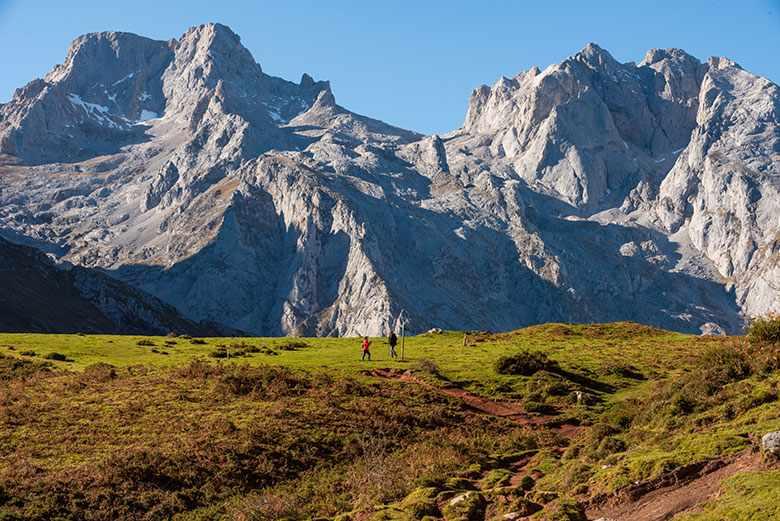
But to enjoy its immensity and its wonderful scenic surroundings, you don't need to climb if you don't feel like it. You can reach the base of this summit on an easy route that leaves from Pandébano (Cabrales), and in a few hours (approximately three) you will be in the Urriellu valley, where there is also a refuge with a hotel and catering service.
A walk through the villages of Picos de Europa
The Picos de Europa and its surroundings, one of the most unique places on the continent, combine the green of the Atlantic vegetation with the limestone and rocky ecosystem of the Picos themselves, and this combination generates dream landscapes, with villages that seem to be taken from a fantasy story.
These are villages that give their name to famous artisan cheeses such as Cabrales or Gamonéu; villages that are the dream of mountaineers and adventurers; villages along which pilgrimage routes and paths pass; villages with incredible panoramic views of the peaks and most emblematic places of the Picos de Europa, and in short, villages that hide artistic and spiritual treasures linked to the foundation of the first Christian kingdom of the Iberian Peninsula in the middle of the Middle Ages.

On a trip to the region of Picos de Europa, one of the villages you cannot miss is Bulnes, although there are also many other villages where you will discover different sensations and landscapes.
Viewpoints with beautiful views of Picos de Europa
The Picos de Europa region, due to its geographical and orographic characteristics, is a land of slopes, and of places that rise up high to contemplate in the distance peaks, valleys, lakes, forests and endless landscapes (as far as your eyesight and the visibility of the day allow).
For this reason, all of its territory is dotted with viewpointsthat are easy to reach , with little effort.

One of these viewpoints is the Mirador de la Princesa, the most recent one inaugurated in the Picos de Europa, specifically in 2018 - when the National Park celebrated its 100th anniversary. Located on Sohornín Peak, it offers beautiful views of the lake and some of the peaks of the Picos de Europa.
The world of the sheepfolds and the shepherds: an experience not to be missed
The 'majadas' are very characteristic places in the Picos de Europa and are closely linked to pastoral activity, since they are the places where shepherds traditionally spent the summer months with their herds - mainly cattle - taking advantage of the pastures and devoting themselves almost exclusively to the production of milk for the production of butter and artisanal cheeses.
With the arrival of autumn, the shepherds moved the cattle down to the stables and grazing areas closer to the villages in the different valleys, where they spent the whole winter.
Precisely one of the cheeses that best reflects these cycles of life is Gamonéu, given that the puertu cheese is made during spring-summer in the sheepfolds and the cattle feed on the high mountain pastures, and the valley cheese, which is made all year round and in this case the cattle feed in lower areas and nearer to rural population centres.
There is also another outstanding artisan cheese in the Picos de Europa, Cabrales. Both Gamonéu and Cabrales have PDO (Protected Designation of Origin) certification.
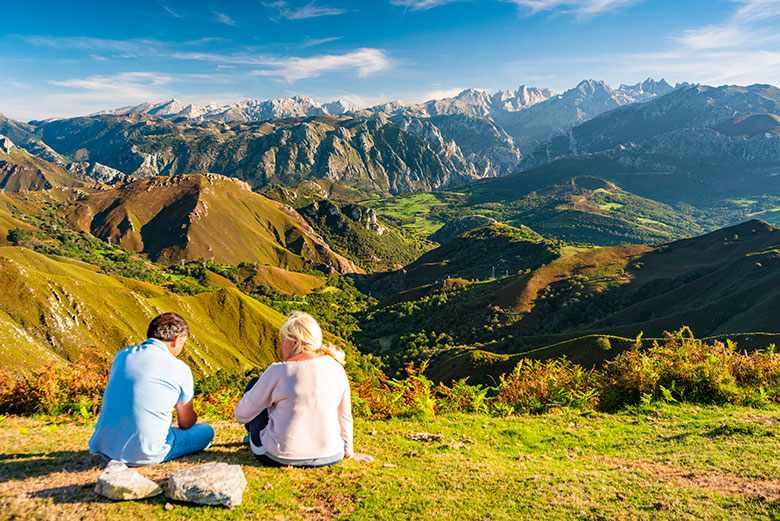
Well, the "majadas" are those enchanting places that you have to visit. There are still many in the Picos de Europa, most of them in the councils of Cangas de Onís and Onís. One of them is Soñín, where Gamonéu del Puertu is traditionally made.
So the cheeses of Picos de Europa are some of the best in the world, so don't miss out on tasting them and getting to know the culture of shepherding!
Mountain routes and active tourism activities for all levels and preferences.
The Picos de Europa region, due to its geographical and scenic characteristics, offers a multitude of routes of different levels and for different preferences.

One of the best known and busiest - especially in high season - is the Cares Route, which is 12 kilometres long (or 24 kilometres round trip) with little gradient and which links Poncebos and Caín (the latter in the Leonese part of the Picos de Europa National Park), but which requires the precautions of a mountain route.
Other routes are also worth mentioning, such as the route from the lakes of Covadonga to Vega de Ario (where there is a refuge), or from the lakes of Covadonga to Vegarredonda (where there is also a refuge).
Others that are classics are the route to the Ordiales viewpoint, the ascent to Bulnes via the Canal del Texu, the route to Ándara lake, or the route to the Cabaña Verónica hut.
And of course, in the Picos de Europa Region it is also possible to do active tourism activities such as canoeing, rafting, canyoning, climbing, running, orienteering races, snowshoeing, ski mountaineering, etc.
A foray into the world of artisan cheese dairies
As you will be fascinated by the landscapes and the history of the cheeses of the Picos de Europa, it is also interesting to visit a cheese factory. Because the cheese culture in this region is very old and very broad, there are many varieties of artisan cheeses, some with PDO - such as Cabrales or Gamonéu -, others with PGI, such as Los Beyos cheese, and many others without certification but of great quality all the same.

There are several cheese dairies that organise guided tours, among others: Vega de Ario, in Onís; Demués, also in Onís, and Maín, El Cabriteru and Vega de Tordín, all three in the council of Cabrales.
Museums, Interpretation Centres and Visitor Centres to get to know the region in depth.
In addition to visits and nature walks, the Picos de Europa region is so culturally rich and humanised that you will want to get to know some of the museums, interpretation centres and visitor centres in the area.
One of these cultural spaces is the Cueva del Quesu, in Arenas de Cabrales.
You will find the Picos de Europa region a fascinating destination!
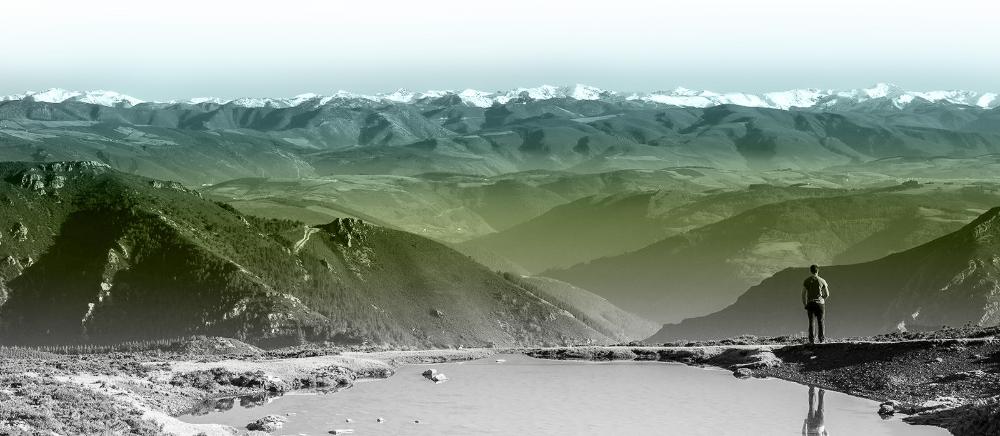
Subscribe to our newsletter and take advantage of offers, discounts, and news
Subscribe

